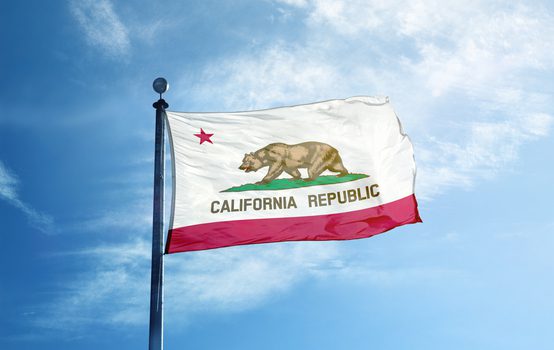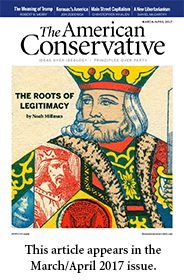California Split

When a previous Republican president launched the Bush family’s second war upon Iraq, a merry band of Vermonters responded with what they called a “peaceful, democratic, grassroots, libertarian populist movement,” dedicated to returning Vermont to its quondam status as an independent republic.
Vermontian to the marrow, soaked in the ethos of direct democracy, playful (they paraded and put on subversive puppet shows) and yet thoughtful enough to have won the enthusiastic approbation of George Kennan and John Kenneth Galbraith, these Green Mountain Boys and Girls didn’t achieve divorce, but they did give us an alluring glimpse of the shape that hope takes in a darkening empire.
The new Republican president has also catalyzed an independence movement, this one in the Golden State, though so far it lacks the intellectual seriousness, rooted radicalism, and wit of the Vermonters.
A Reuters poll in January found that 32 percent of Californians favor secession from the union, but the post-election Trump bump for “Calexit”—can’t we at least call it “California Split,” after one of Robert Altman’s only good movies?—owes as much to petulance as principle.
The most cogent arguments of the Yes California Independence Campaign, which seeks a 2018 statewide referendum as a first step toward seceding from the United States, are 1) it’s better to send your tax dollars to Sacramento than to Washington; 2) no longer will peaceable Californians (Charles Manson? The Zodiac Killer? Raiders fans?) be forced to subsidize foreign wars; and 3) California, which has 39 million people and “the sixth largest economy in the world,” is fully capable of tending its own affairs.
Dreary dour men lecture the idealists that breaking away is “unrealistic.”
In Texas v. White (1869), the U.S. Supreme Court held that the Lone Star State never actually left the union during the Civil War because to do so would have been a constitutional and metaphysical impossibility. But Chief Justice Salmon Chase—“a good man,” said his fellow Buckeye Ben Wade, “but his theology is unsound; he thinks there is a fourth person in the Trinity”—left open the possibility that a state could detach itself if it obtained the “consent of the States.”
You think Nebraska would vote against, let alone send troops to prevent, California’s secession today?
When Bella Abzug campaigned in 1971 for New York City statehood, the Buffalo City Council responded with a “good riddance” resolution. I daresay California, too, would be pelted by a hailstorm of Godspeeds and fare-thee-wells.
For “to hold men together by paper or seal or by compulsion is no account,” as Walt Whitman said. It is not only immoral but ridiculous to compel people, by means including murder, to remain in a political union against their will. (Elucidation is provided in my 2010 page-turner, Bye-Bye, Miss American Empire.)
When the Trump hangover fades, and with it the appeal of divorce, frustrated Californians really ought to go fission.
As Carey McWilliams wrote in his history of the state, California might have entered the union in 1850 as two states but for the suspicion that the “disaffected Mexican element” of the South might form an “irredentist movement” to reconnect with the motherland. The South was agricultural, settled, Spanish: the North was wild, transient, gold-crazed. The Sacramento Union editorialized in 1853 that a “division of the state into two or more states is a political necessity which will be recognized by all parties sooner or later.”
Sooner was more like it. In 1859, Southern Californians overwhelmingly voted in a referendum for a state of their own. Committees in the U.S. House and Senate approved, but then, as Abraham Lincoln morosely remarked, the war came. Decentralization died.
But a California split was too good an idea to ever vanish. It reappeared in the 1910s, as Northern Californians resented the moralizing prohibitionists of what they sneeringly called “Puritangeles.” (Times do change.)
 Half a century later, ex-Governor Pat Brown, Jerry’s father, supported division as a way to get San Francisco out from under the boot heel of Ronald Reagan, Puritangeles Mayor Sam Yorty, and the John Birchers of Orange County.
Half a century later, ex-Governor Pat Brown, Jerry’s father, supported division as a way to get San Francisco out from under the boot heel of Ronald Reagan, Puritangeles Mayor Sam Yorty, and the John Birchers of Orange County.
By the 1990s, separatist sentiment was strongest in the rural far north, whose lumberjacks and pot growers and pickup drivers revived the pre-World War II proposal to meld northern California and southern Oregon into the felicitously named State of Jefferson.
If the anti-Trump independentistas fall short, why not trisect California into three states? If you object to redesigning the flag, just undo a pair of imperialistic offenses against contiguity by granting Hawaii and Alaska their independence.
I know: this is dreamy and unrealistic and could never happen in a billion years. Tell it to President Jeb Bush and the guy who bet the house against the Chicago Cubs.
Bill Kauffman is the author of 10 books, among them Dispatches from the Muckdog Gazette and Ain’t My America.
Comments